Military Knowledge: Arrow Anti-Ballistic System

The Arrow is a series of anti-ballistic missiles jointly funded, developed and produced by the Israeli regime and the United States of America. This system is considered to be the most effective and strongest anti-ballistic system of the Israel regime, and it was specially developed to deal with Iran’s ballistic missiles.
History and development:
After the First Persian Gulf War and Saddam’s use of the Al-Hussein missile against some neighboring countries such as Saudi Arabia, exposed the controversial performance the Patriot air defense system, And the production program of the anti-ballistic system was specially placed on the agenda of the Israeli regime.
The Arrow anti-ballistic system has been jointly funded and developed by Israel and the United States since 1986, and its production and development process has continued until today. According to the Israeli regime, this system is more effective than the American MIM-104 Patriot system to repel ballistic missile attacks.
Undertaken by the MALAM division of the Israel Aerospace Industries (IAI) and Boeing, it is overseen by the Israeli Ministry of Defense’s “Homa” administration and the U.S. Missile Defense Agency.
Israel initially produced the Arrow system domestically, but on February 11, 2003, IAI and Boeing signed an agreement, valued at over $25 million for fiscal years 2003–2004, to establish production facilities for the manufacture of components for the Arrow missile in the United States. In March 2004, IAI awarded a $78 million production contract to Boeing; the total contract value could exceed $225 million through second quarter 2008. As a result of successful implementation of this contract Boeing is responsible for production of about 35 percent of Arrow missile components, including the electronics section, booster motor case and missile canister, at its Huntsville, Alabama, facilities. IAI, the prime contractor of the Arrow system, is responsible for integration and the final assembly of the Arrow missile in Israel.
Boeing also coordinates the production of Arrow missile components manufactured by more than 150 American companies located in over 25 states.
Today, Boeing’s share in the production of the “Arrow 3” system has reached 40-50%.
The first launch of the Arrow interceptor took place on August 9, 1990, designed to test the missile’s control and guidance systems. This test was stopped after a few seconds due to a malfunction in the systems and the missile was destroyed in the sky. This missile had several unsuccessful tests in 1991. Although the missile was finally successful in 1992, and the missile design was changed to Arrow 2. Although Arrow 2 also encountered problems many times, after solving the problems in 1998, the Arrow 2 system was delivered to the army for testing.
On March 14, 2000, the first complete Arrow 2 battery was rolled out in a ceremony at Palmachim Airbase.
In June 2001 Arrow missiles were test-fired in the course of a joint American-Israeli-Turkish exercise code-named Anatolian Eagle, in the southeast of Turkey.
In October 2002 the second battery was declared operational.
In the continuation of the development of the Arrow anti-ballistic system, changes were made on the Arrow 2 missile, and each of these changes was placed in different blocks. The Arrow 2 block-2 missile entered the test phase in 2003. In 2007, Arrow 2 block-3 was also tested. In September 2008, a Blue Sparrow missile, capable of simulating “Scud-C/D” missiles was used to test the Arrow 2 block-4, but the test failed; The next test was repeated on April 7, 2009 and this time it was successful.
By August 2008 the United States and Israeli governments have initiated development of an upper-tier component to the Israeli Air Defense Command, known as Arrow 3. The development is based on an architecture definition study conducted in 2006–2007, determining the need for the upper-tier component to be integrated into Israel’s ballistic missile defense system. According to Arieh Herzog, the main element of this upper tier will be an exoatmospheric interceptor, to be jointly developed by IAI and Boeing. Arrow 3 was declared operational on January 18, 2017.
By April 2011 Israel’s Missile Defense Organization (IMDO) launched initial definition of a new block-5 upgrade to the complete Arrow system that will merge the lower-tier Arrow 2 and exoatmospheric Arrow 3 into a single national missile defense system. According to Arieh Herzog, the planned block-5 will include new ground- and airborne sensors, a command and control system, and a new target missile – the Silver Sparrow – to simulate potentially nuclear-capable delivery vehicles developed by Iran.[68] According to the U.S. Missile Defense Agency, block-5 is expected to be able to deal with “more stressing regional threats” by increasing total defended area by some 50 percent.
In 2017, the Arrow 4 system was defined and put on the agenda for future complex threats. These threats included hypersonic cruise missiles or any other supersonic aircraft. It should be noted that research on Arrow 4 has gained more speed after the unveiling of the Iranian Fattah hypersonic missile.
Read more:
Military Knowledge: Fattah Hypersonic Ballistic Missile
Military Knowledge: Fattah-2 Hypersonic Missile
Until today, parts of Arrow anti-ballistic system, such as radar, have been exported to countries such as the Republic of Azerbaijan. But Arrow, as a complete system, serves only in the army of the Israeli regime. It should be noted that a contract for the full sale of the Arrow system has recently been concluded with Germany.
Financial sources of the project:
From the beginning of the design of the Arrow anti-ballistic system, the United States has had a direct role in financing it. Estimated credits required for this project are 1.6 billion dollars and the price of each Arrow missile is estimated at 3 million dollars. However, according to the financial report of the Congressional Research Service (CRS) published in 2023, the total financial assistance of the United States to the Arrow anti-ballistic system reaches 4.5 billion dollars.
Estimates of Israel’s spending on the Arrow program show that Israel has spent more than 60 million dollars annually for this project independently, which amounts to more than 2 billion dollars. As a result, the Arrow anti-ballistic system program has cost more than 6.5 billion dollars so far.

Design and parts:
The Arrow system consists of the hypersonic Arrow anti-missile interceptors, Arrow 2 and Arrow 3, the Elta EL/M-2080 “Green Pine” and “Great Pine” early-warning AESA radars, the Elisra “Golden Citron” (“Citron Tree”) C3I center, and “Brown Hazelnut” (“Hazelnut Tree”) launch control center. The system is mobile and can be moved to other prepared sites.
Each missile of the system is placed in a canister and all 6 of them are placed on a truck. Each Arrow anti-ballistic system battalion includes 4 to 8 mobile launchers (24 to 48 missiles), a mobile Green Pine early warning radar unit, a radar power supply unit truck, a radar cooling unit truck, a radar control unit truck, a Elisra Golden Citron control center, Brown Hazelnut mobile launch control center and mobile communications center, resulting in 11 to 15 trucks per battalion.

Green Pine early warning radar:
The Green Pine early warning radar model EL/M-2080 has a range of 500 km and the Block-B Super Green Pine version or EL/M-2080s has a range of 900 km. This radar also has a Block-C version, the specifications of which have not been revealed yet.
The Green Pine radar is an active electronically scanned array (AESA) radar. This radar is active in the X-band and is capable of detecting 30 targets at a speed of 3000 meters per second (equivalent to Mach 8.8) in a maximum range of 500 to 900 km depending on the model. The accuracy of missile guidance by the green pine radar is up to 4 meters of the target, and after that the missile acquires the target and hits with its own radar.
The Green Pine early warning radar antenna has a width of 9 meters and a height of 3 meters. This radar system consists of an antenna, a power system (including a diesel generator and fuel tank), a cooling system and a radar control center, and it has 2000 to 2300 modules that send and receive waves and weighs 60 tons.
The Green Pine radar is mobile and can be moved using 4 trailers, but it is not possible to set it up anywhere. In general, it takes about 24 hours to set up a green pine in a new operational site.
Read more: Military Knowledge: Green Pine Radar
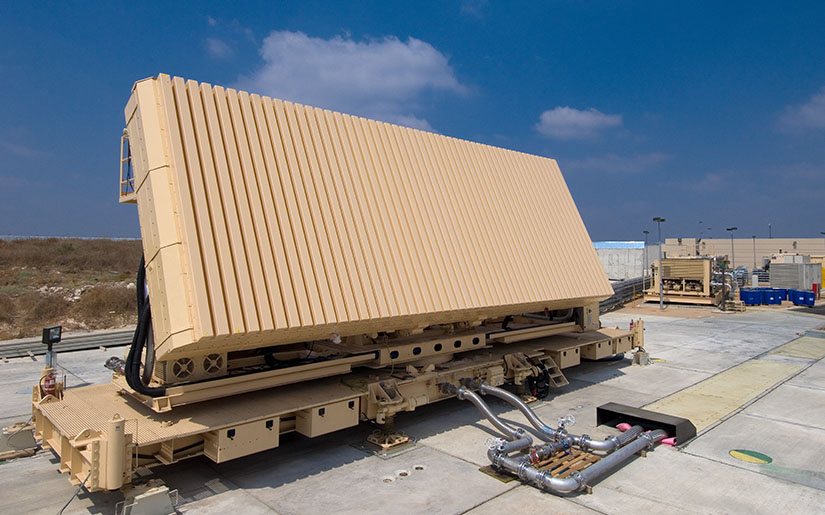
Golden Citron control center
The “Golden Citron” truck-mounted net-centric open systems architecture Battle Management Command, Control, Communication & Intelligence Center can control up to 14 intercepts simultaneously. The system provides fully automatic as well as Human-in-the-Loop options at every stage of battle operation management. It is also capable of interoperability with other theater missile defense systems and C3I systems. Notably Link 16, TADIL-J, communications were being altered to allow interoperability with Patriot fire control units. Assigned targets can be handed over to the Patriot’s AN/MPQ-53 fire control radar. The “Golden Citron” has three banks of operator consoles laid out in a U shape. All in all, the “Golden Citron” is manned by 7–10 operators.
Brown Hazelnut launch control:
The “Brown Hazelnut” launch control center is located at the launch site, up to 300 km from the “Golden Citron” fire control center. It employs microwave and radio data and voice communications links to the “Green Pine” and “Golden Citron”. The launch method is a vertical hot launch from a sealed canister, providing all-azimuth coverage. “Brown Hazelnut” also has missile maintenance and diagnostic capabilities
Missiles (interceptors):
The Arrow anti-ballistic system includes several missiles, including Arrow 1, Arrow 2 (including five models), Arrow 3 and Arrow 4.
Arrow 1:
The Arrow 1 was a two-stage solid propellant missile that was not put into service. The test of this missile failed on August 9, 1990. The ninth and last test of this missile, which was successful, was conducted on June 12, 1994, from a ship in the Mediterranean Sea. Although several tests of this missile failed and some of them were successful, but in the end this missile was not put into service; And the development of Arrow 1 ceased and further research continued with the “smaller, faster and more lethal” Arrow 2 missile.
This Arrow 1 had inertial and command update mid-course guidance, with a terminal infrared focal plane array. Also, the Arrow-1 interceptor had the capability of thrust vectoring in both stages. The exact specifications of the Arrow 1 missile have not been revealed, but its estimated specifications are available.
Specifications of Arrow 1:
Length: 7.5 meters
Body diameter: 1.2 meters
Length of the second stage: 2.5 meters
Weight: about 2000 kg
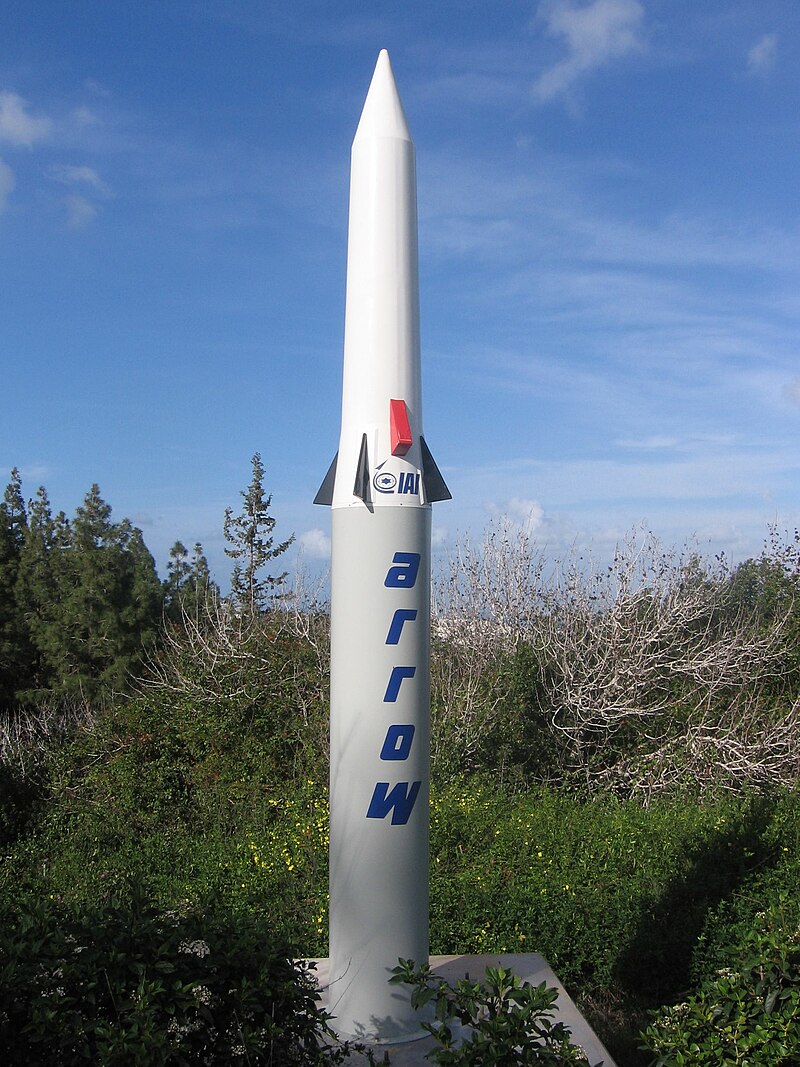
Arrow 2:
The Arrow 2 missile project was developed to achieve a smaller but faster and more lethal missile. The development of this missile started in 1994 and it successfully passed its first tests on July 30, 1995. These experiments continued until 1998. On November 1, 1999, an Arrow 2 missile successfully intercepted and destroyed a Scud missile. After this success, the first battalion of this system was activated on March 14, 2000 during a ceremony at the Palmachim Air Base.
This two-stage missile is equipped with solid propellant booster and sustainer rocket motors. The Arrow-2 missile uses an initial burn to carry out a vertical hot launch from the container and a secondary burn to sustain the missile’s trajectory towards the target at a speed of Mach 9. Thrust vector control is used in the boost and sustainer phases of flight. At the ignition of the second stage sustainer motor, the first stage assembly separates. The Arrow missile is launched before the threat missile’s trajectory and intercept point are accurately known. As more trajectory data becomes available, the optimum intercept point is more precisely defined, towards which the missiles is then guided. The 500 kg kill vehicle section of the missile, containing the warhead, fusing and the terminal seeker, is equipped with four moving delta aerodynamic control fins to give low altitude interception capability. The dual mode missile seeker has a passive infrared seeker for the acquisition and tracking of tactical ballistic missiles and an active radar seeker used to home on air-breathing targets at low altitudes. The infrared seeker is an indium antimonide focal plane array.
The kill vehicle is designed to achieve a hit-to-kill interception, but if this is not achieved, the proximity fuze will direct the warhead fragments at the target shortly before reaching the closest point to the target. The high explosive directed blast fragmentation warhead is capable of destroying a target within a 40–50 m radius. In this manner, Arrow also differs from Patriot PAC-3, THAAD, and Standard Missile 3, which rely purely on hit-to-kill technology in which the kinetic force of a precise impact causes the destruction of the threat.
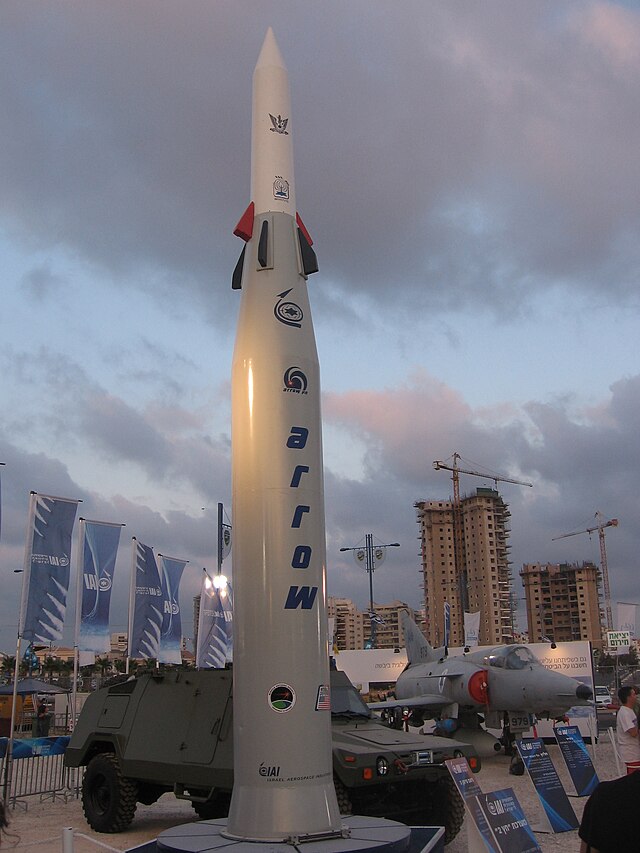
Arrow 2 Block-2 missile:
A successful test of the Arrow 2 block-2 took place on January 5, 2003. Four missiles were launched towards four simulated targets in order to examine the interceptor’s performance during special flight conditions as well as system performance during a sequence of launches. The test did not include actual interceptions. Another successful test held on December 16, 2003, examined the system’s ability to intercept and destroy incoming missiles at significantly high altitudes, around 60 km.
On July 29, 2004, Israel and the United States carried out a joint test at the Naval Air Station Point Mugu Missile Test Center in California, in which the Arrow interceptor was launched against a real “Scud-B” missile. The test was a success, with the interceptor destroying the “Scud” that flew a 300 km (190 mi) trajectory at an altitude of 40 km.
This system conducted another test on August 26, 2005. This test was aimed at examining the Arrow’s ability to detect a splitting warhead of a separating ballistic missile. During the test, despite the correct detection, it could not destroy it due to a technical defect.
In March–April 2005 the ability of “Green Pine” and “Golden Citron” to work with Patriot system elements operated by U.S. Army was successfully tested against simulated “Scud”-type targets during regular series of U.S.–Israeli biennial exercises code-named “Juniper Cobra”.
Actual testing of the complete Arrow system was resumed in December 2005, when the system successfully intercepted a target at an unspecified but reported record low altitude.

Arrow 2 Block-3 missile:
On February 11, 2007, an Arrow 2 block-3 successfully intercepted and destroyed a “Black Sparrow” target missile simulating a ballistic missile at high altitude. It was the first so-called distributed weapon system test conducted in Israel, which required two Arrow units deployed some 100 km apart to share data on incoming threats and coordinate launching assignments. It was also the first time the Link 16 data distribution system was used to connect two Arrow units.
Arrow 2 Block-4 missile:
On April 15, 2008, the Arrow system successfully detected and made a simulated intercept of a new target missile. During the test, a target missile was launched from an Israeli F-15 at a height of 27.5 km. The missile split into multiple warheads, making it harder to intercept it. Nevertheless, “Green Pine” tracked the warhead, simulating an intercept. In September 2008, another test attempted against the “Blue Sparrow” missile but the test failed. Eventually the Arrow 2 block-4 was successfully tested against the “Blue Sparrow” on April 7, 2009.
This missile was also tested on July 22, 2009 against an airborne missile with a range of 100 km fired from a C-17 Globemaster III transport aircraft, but the test was unsuccessful.
This missile successfully passed several other tests until 2015. These tests revealed the need to create a new Battle Management Center, launchers with high shooting availability, better communication with other missile systems and wider ranges of interceptions. Because the probability of success was not high and better launchers should have been used to protect the crew. Also, the control center was facing problems in transmission and correct detection of the firing position, which had to be solved.
Arrow 2 Block-5 missile:
By April 2011 Israel’s Missile Defense Organization (IMDO) launched initial definition of a new block-5 upgrade to the complete Arrow system that will merge the lower-tier Arrow 2 and exoatmospheric Arrow 3 into a single national missile defense system. So, a new ground and airborne sensors, a command and control system, and a new target missile – the Silver Sparrow – to simulate potentially nuclear-capable delivery vehicles were defined for test.
The planned block-5 will optimize the existing Super Green Pine radar to operate with the AN/TPY-2 radar as well as with radars commanding anti-ballistic missiles aboard United States Navy destroyers. U.S. radars will be used to support closed-loop operations if Israel and U.S. targets in the region come under attack.
Arrow 3:
By August 2008 the United States and Israel have initiated development of an upper-tier component to the Israeli Air Defense Command, known as Arrow 3. Arrow 3 missile was tested on January 23, 2012 and was declared operational on January 18, 2017.
Arrow 3 operates at greater speeds, greater range and at greater altitudes than Arrow 2, intercepting ballistic missiles during the space-flight portion of their trajectory.
Arrow 3 is a two-stage solid fueled missile. Unlike the Arrow 2 missile, this missile only uses “Hit-to-Kill” method to deal with ballistic missiles. The concept of Hit-to-Kill uses the effect of kinetic energy and direct impact to destroy the target instead of proximity fuze. These types of weapons are also called kinetic energy weapons.
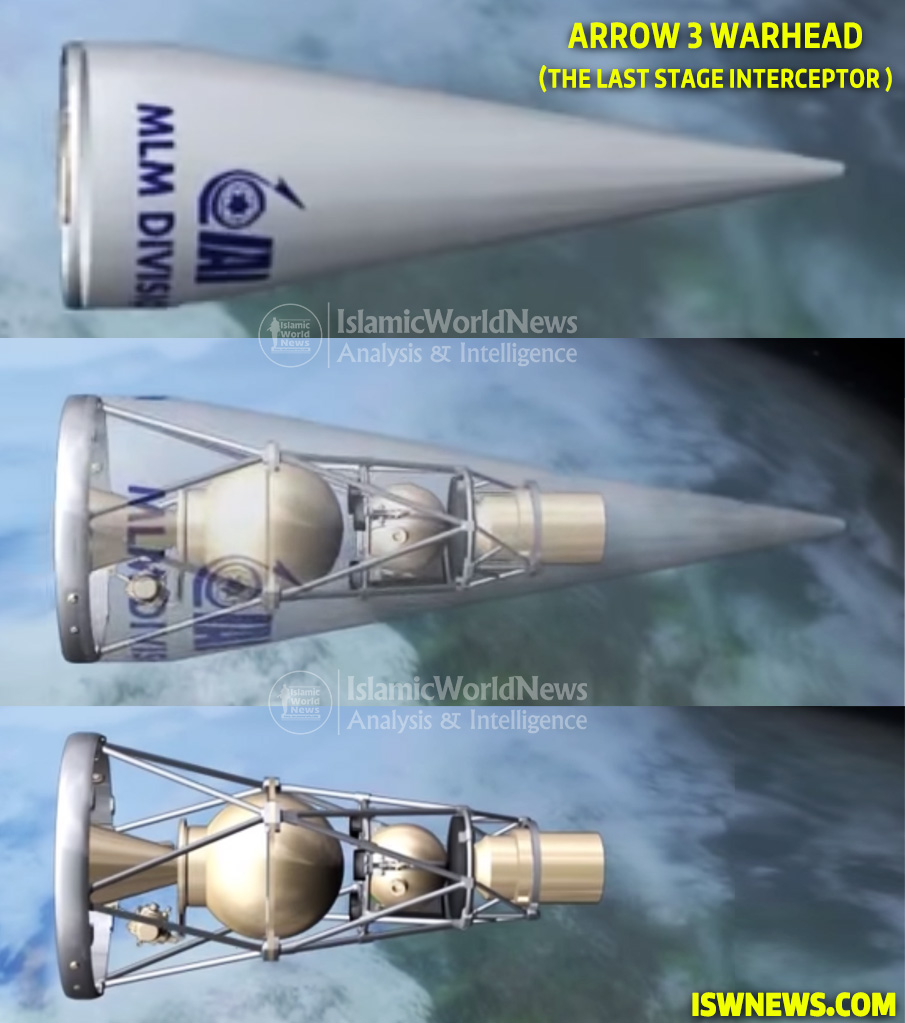
The interceptor part of the last stage of this missile consists of a solid fueled propellant with the ability a thrust vectoring, which is very reliable at the same time as simplicity and cheapness. At the tip of this section, there is an infrared seeker that tracks the target and provides the possibility of high accuracy.
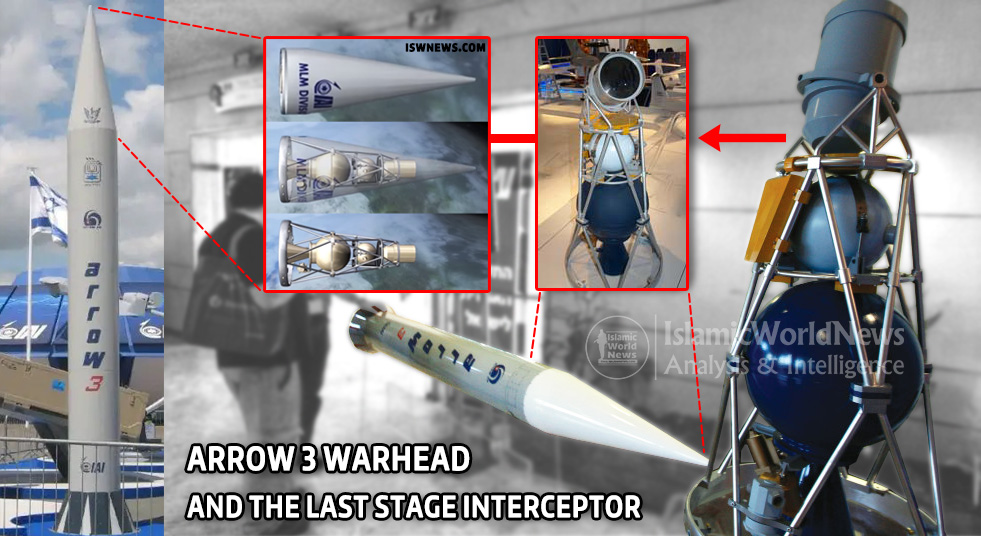
This missile and its system are designed to intercept targets at an altitude of more than 100 km and with longer ranges; Thus, the range of this missile reaches 2400 km.
The interception capability of this system has not been revealed, but the Arrow 3 system is expected to intercept 5 ballistic missiles within 30 seconds.
According to Isaac Ben Yisrael, the former chairman of the Israeli Space Agency, Arrow 3 may serve as an anti-satellite weapon, which would make Israel one of the world’s few countries capable of shooting down satellites.
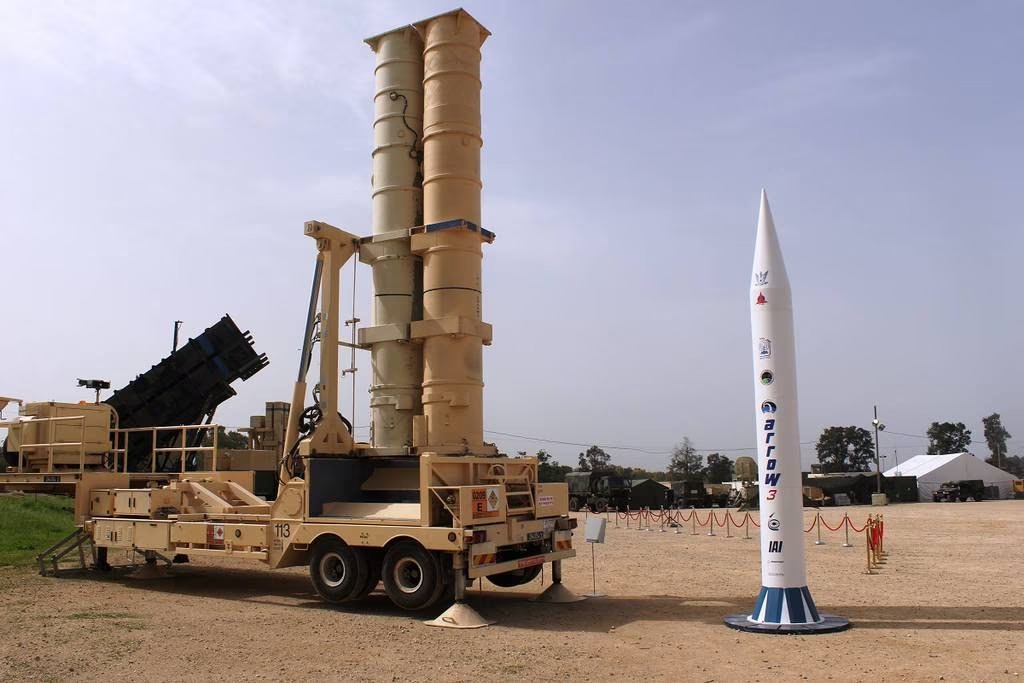
Arrow 4 missile:
In 2017, after the Arrow 3 missile entered service, the Israeli Ministry of Defense set a new goal and plan for defense against future threats. The main goal was to deal with hypersonic missiles. These weapons, whether cruise or ballistic, were among the targets that could not be intercepted and engaged by the Arrow system. In the new program, the goal was to develop a new radar and a new control center and a new missile.
In early 2021 Israel revealed that the development of the Arrow 4 interceptor was ongoing and that the system was targeting the interception of hypersonic threats such as hypersonic cruise missiles and hypersonic glide vehicles. Efforts to counter hypersonic threats took on new urgency following a November 2022 announcement by Iran that they had tested a hypersonic missile that could hit Israel in as little as four minutes.
Read more:
Military Knowledge: Fattah Hypersonic Ballistic Missile
Military Knowledge: Fattah-2 Hypersonic Missile
Specifications of Arrow anti-ballistic missile system:
Type: Anti-Ballistic Missile
Origin: Israeli and American regime
Manufacturer: Israel Aerospace Industries and Boeing Defense, Space & Security (BDS)
Entered service: since 2000
Arrow 2 missile:
Range: 150 km
Speed: Mach 9
Flight altitude: 50 km
Length: 6.8 to 7 meters
Diameter: 500 mm
Weight: 2800 kg
Warhead: 150 kg HE fragmentation
Propulsion: two-stage solid propellant
Guidance: PRH – ARH
Arrow 3 missile:
Range: 2400 km
Speed: Not disclosed
Altitude of fire: more than 100 km
Length: Not disclosed
Diameter: about 0.5 meters
Weight: Not disclosed
Warhead: Hit-to-Kill
Propulsion: two-stage solid propellant
Guidance: INS – Gimbaled seeker
Radar: EL/M-2080 Green Pine
Detection range: 500 km in EL/M-2080 – 900 km in EL/M-2080s
Engagement range: 300 km at an altitude of 40 km against the Scud missile
Number of simultaneously detected targets: 30 targets with a maximum speed of Mach 8.8
Number of simultaneously engaged targets: Not disclosed
Reaction time: Not disclosed
Batteries: 6 launchers mounted on a trailer

More images of Arrow system:
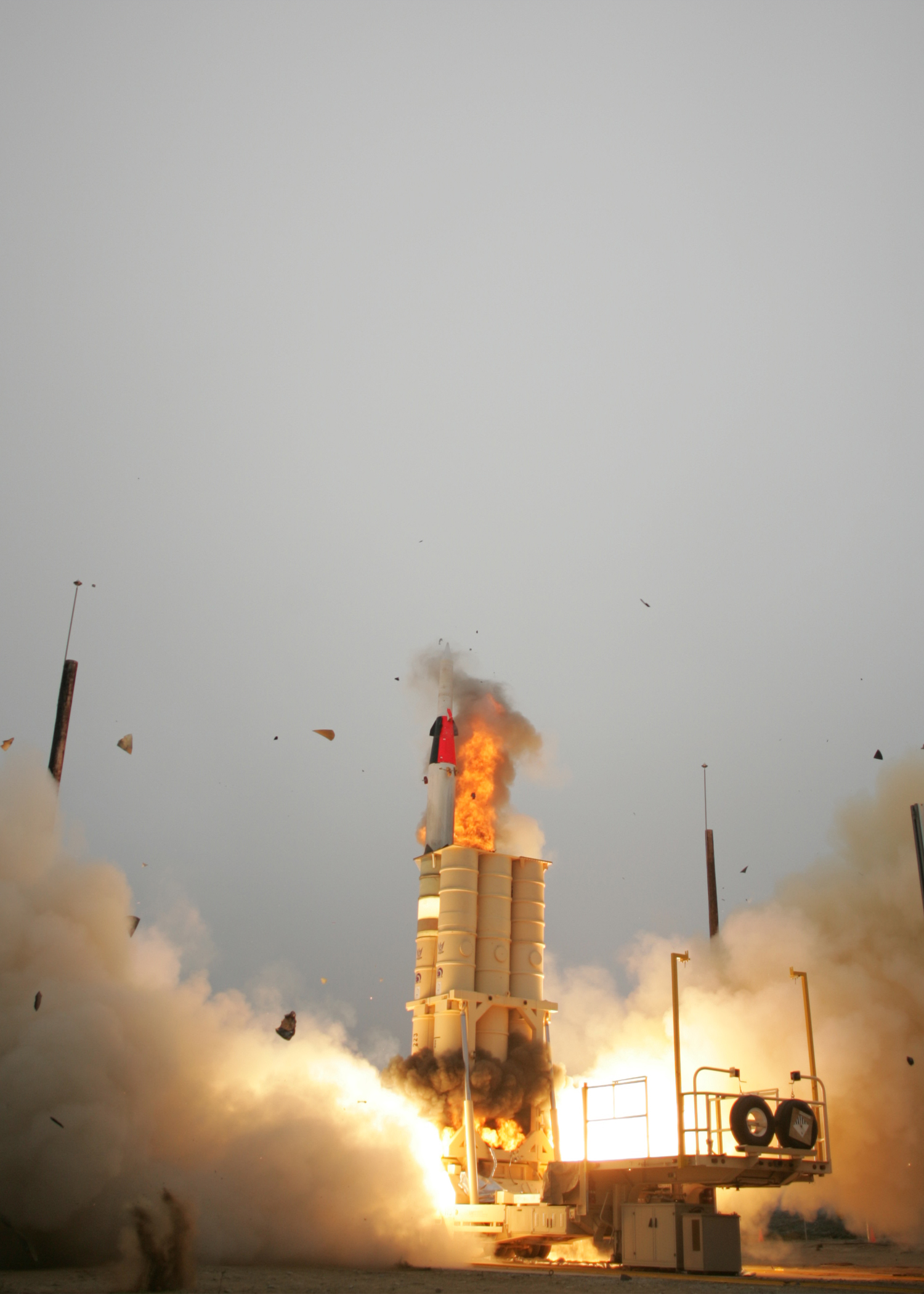
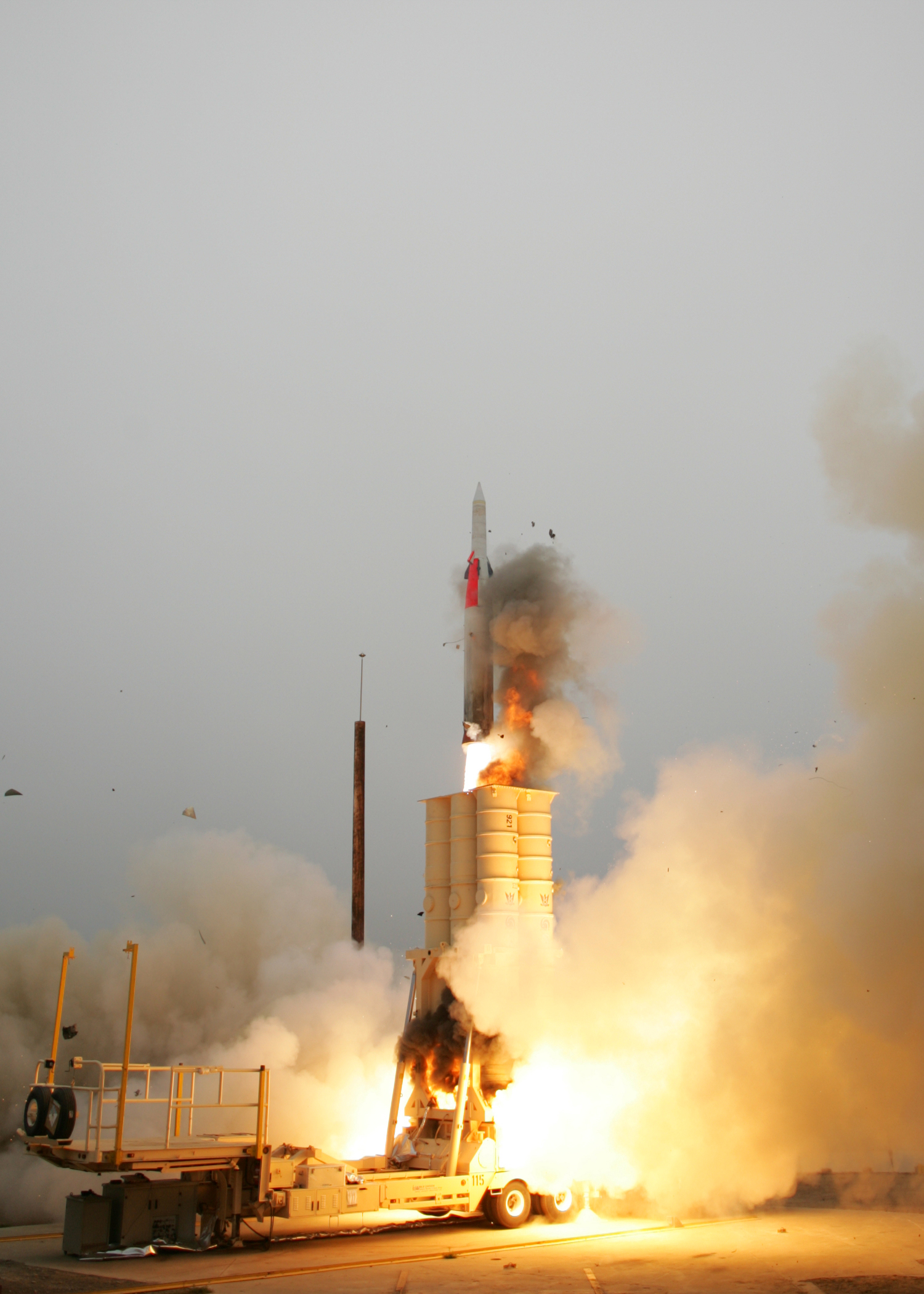

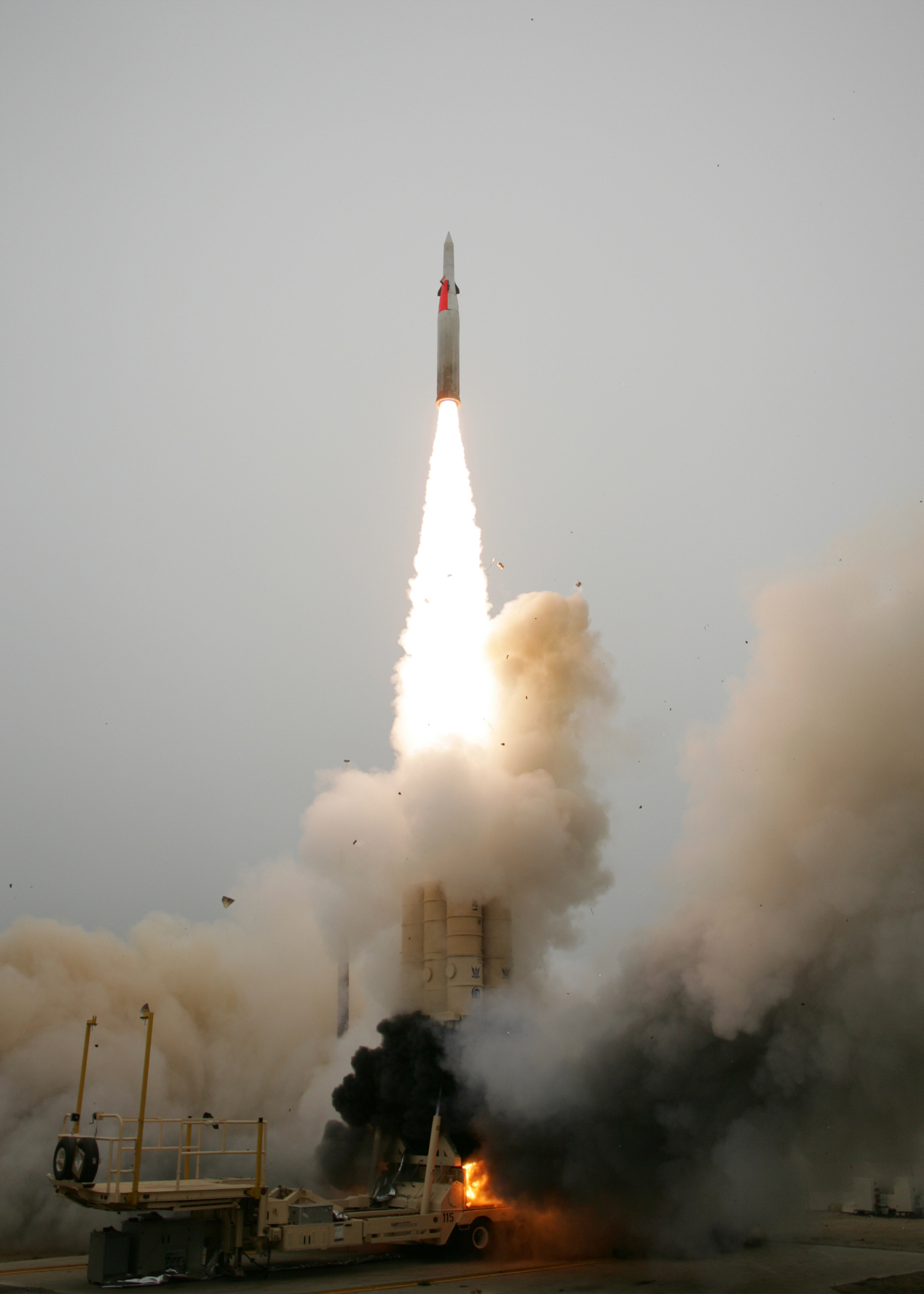
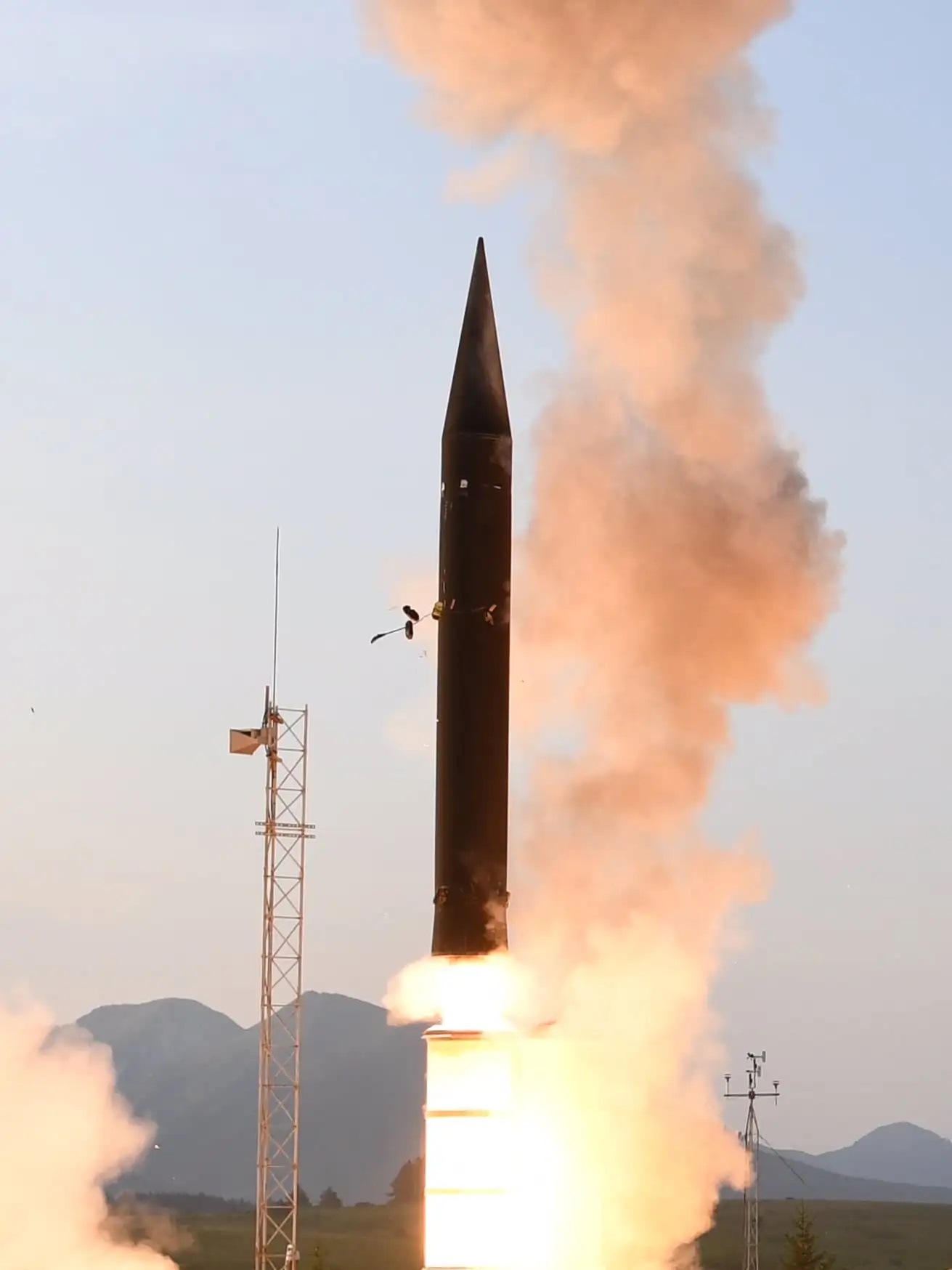
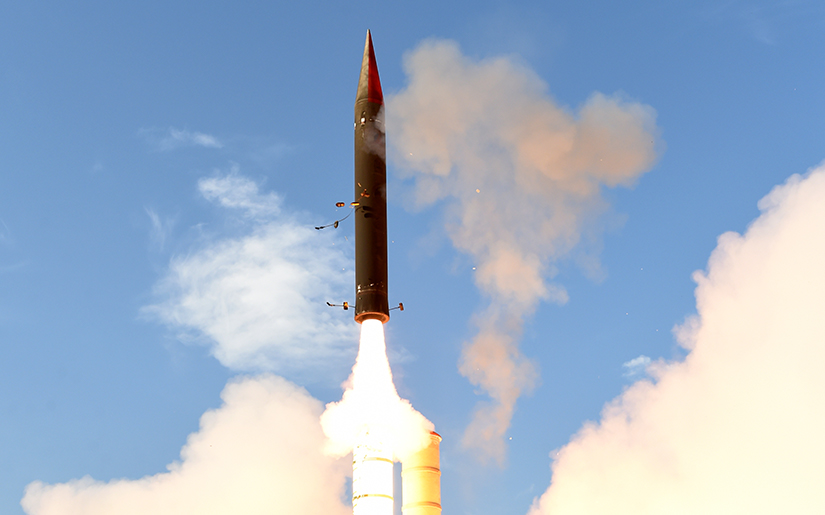
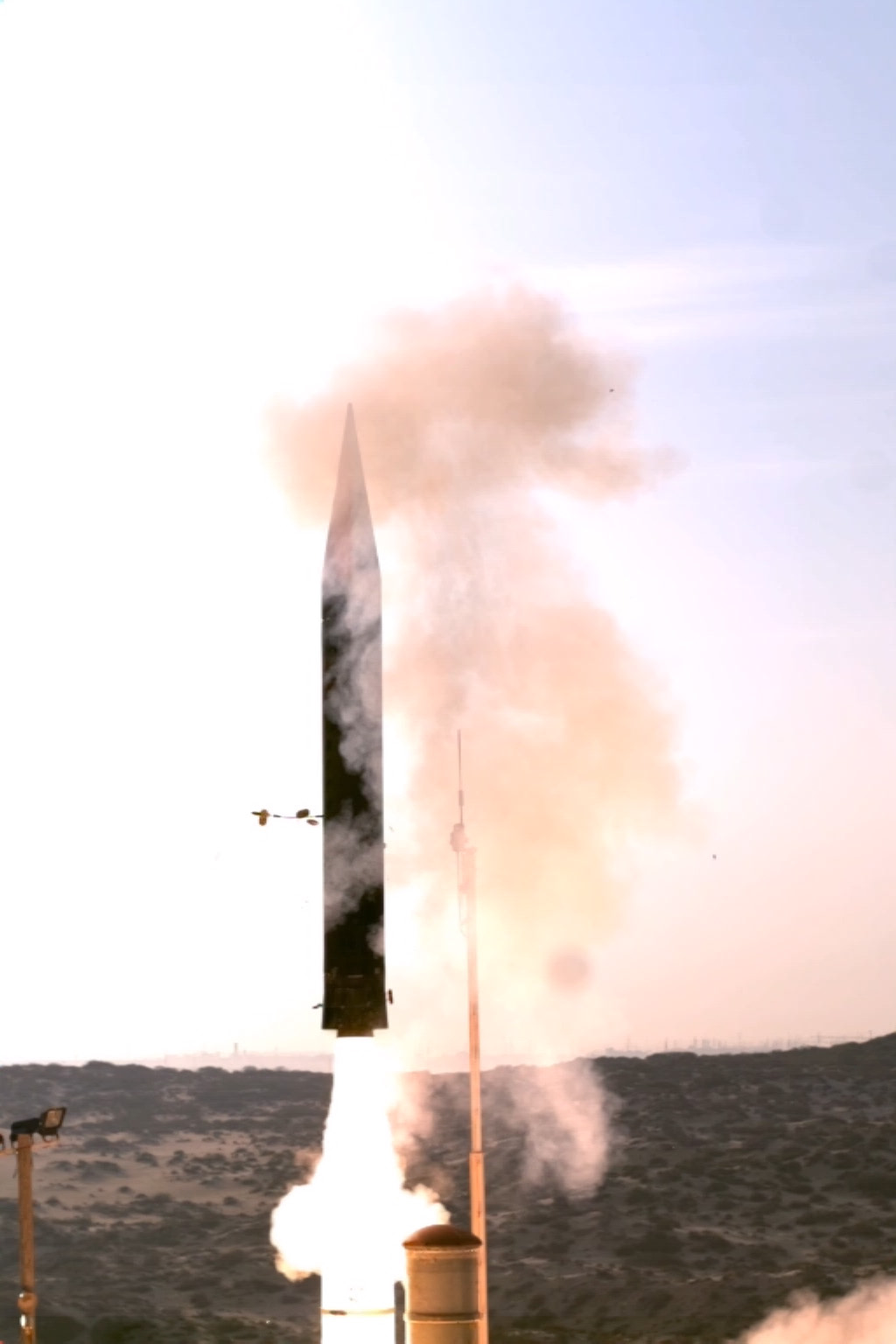
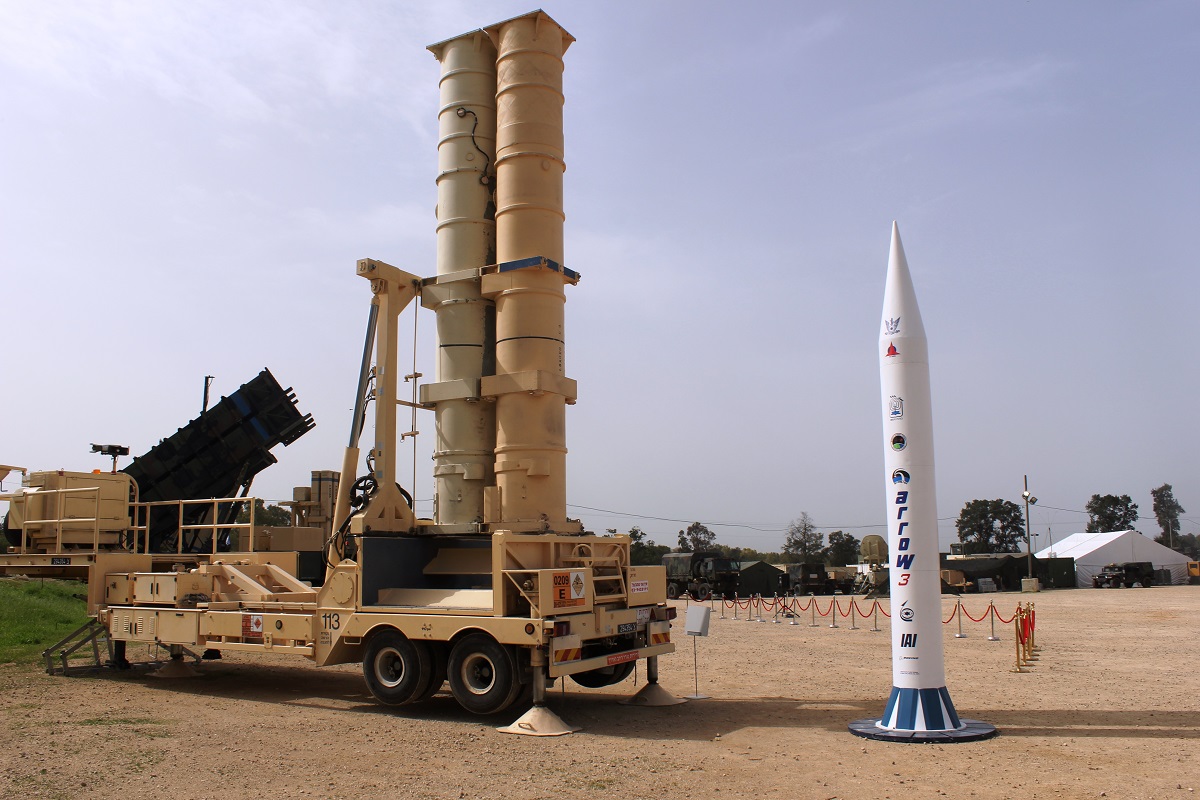
Infographics of ‘Arrow anti-ballistic missile system’ in Farsi, Hebrew, Russian and Azeri:
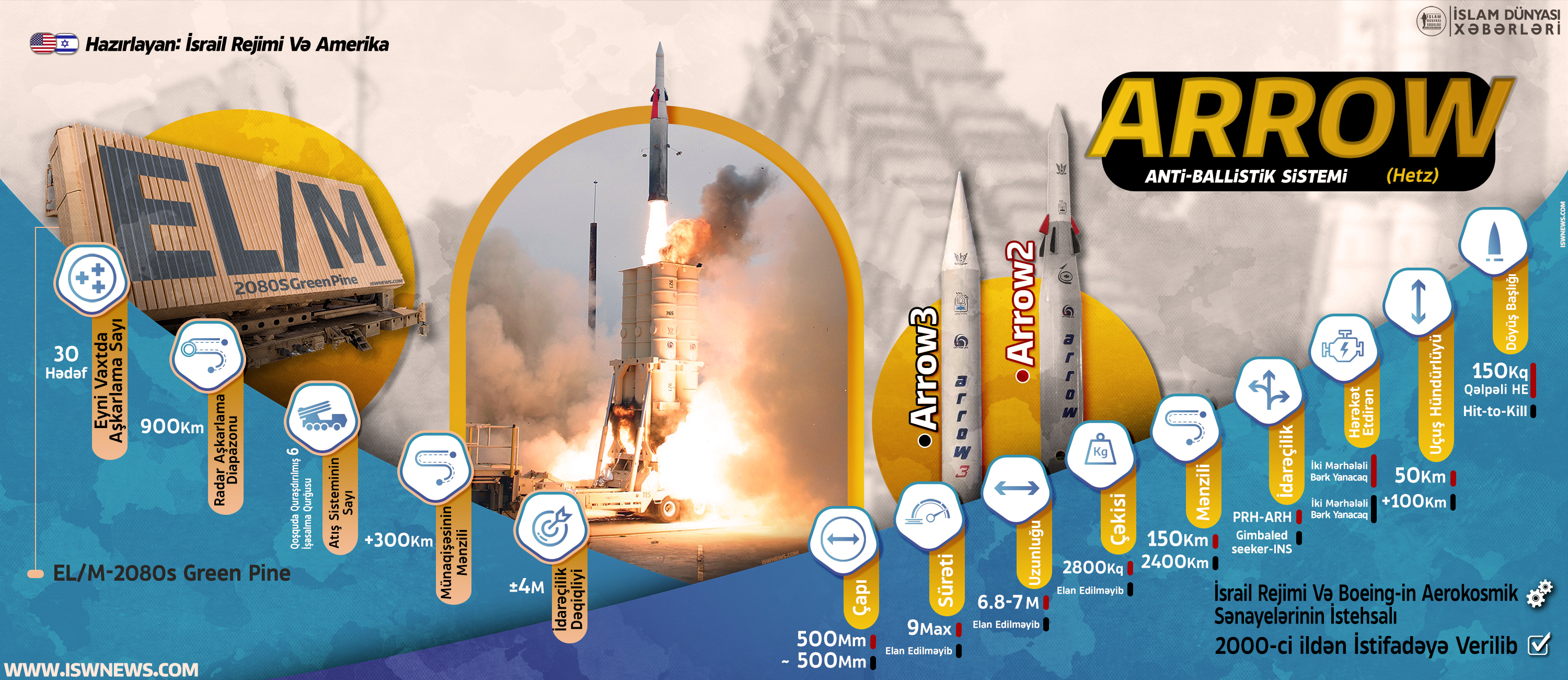
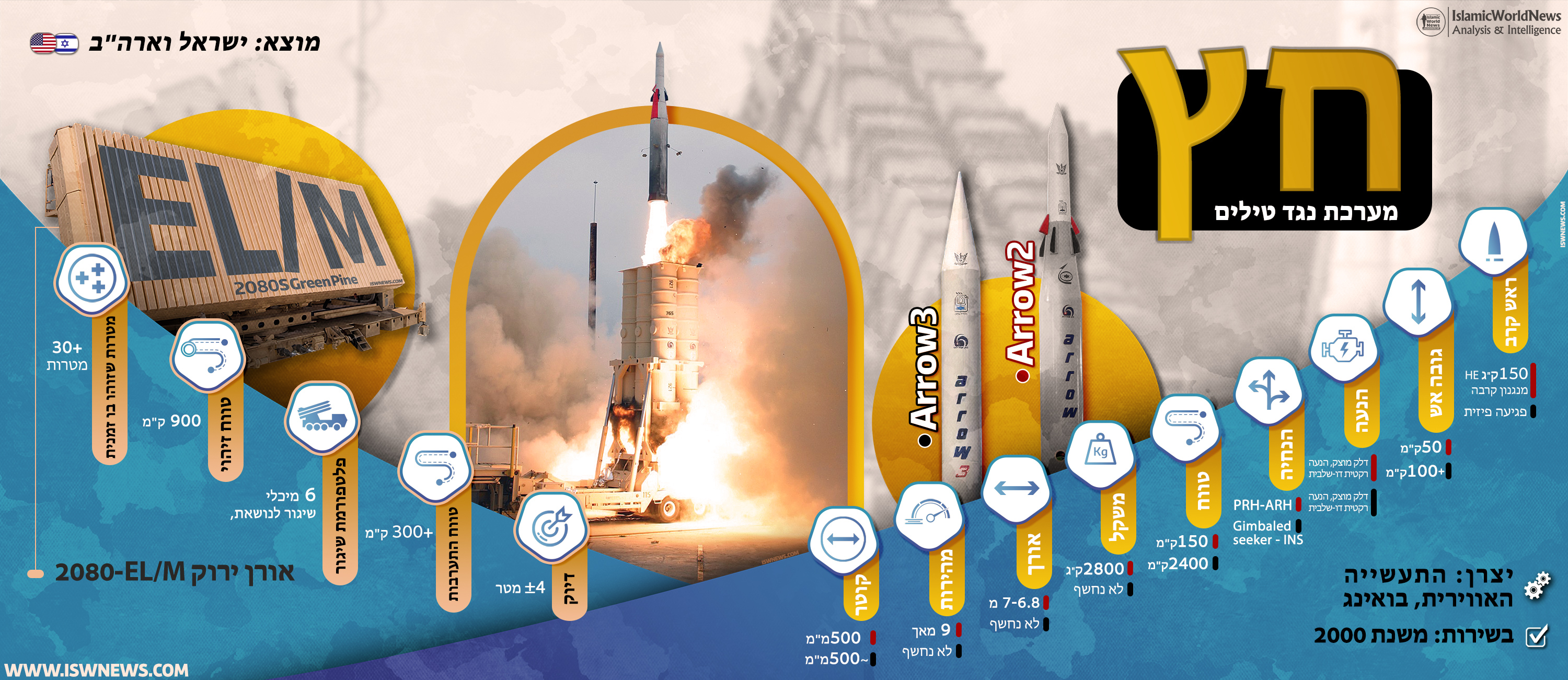
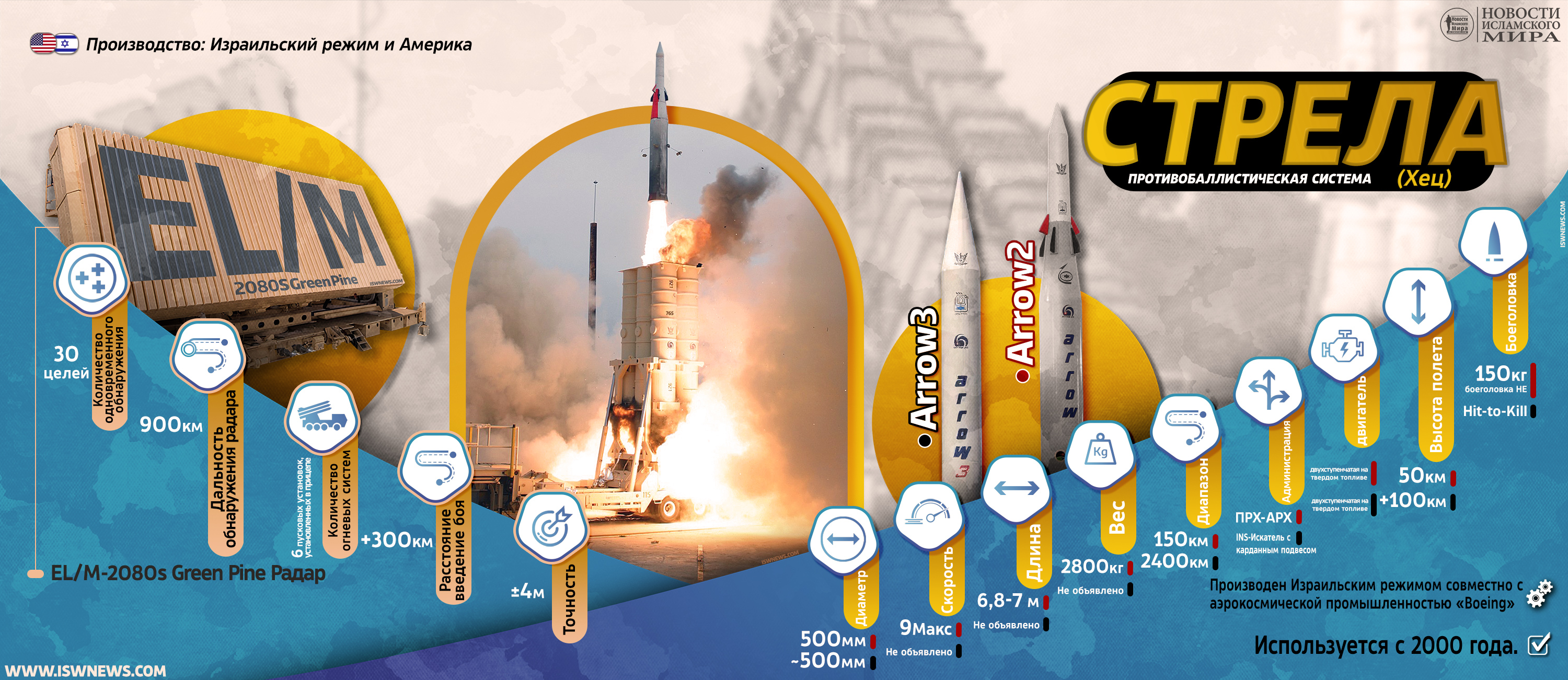
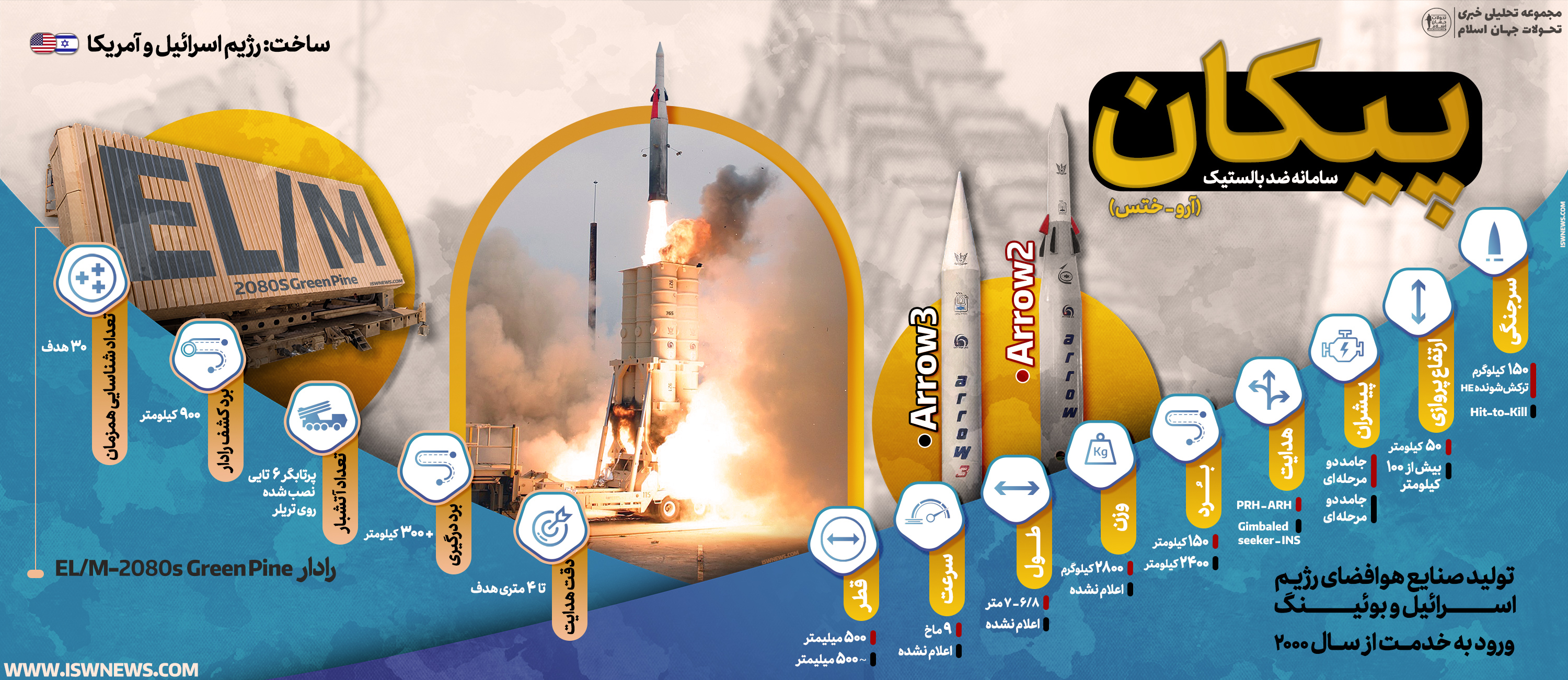
Sources:
Arrow (missile family)
Arrow 2 Theatre Ballistic Missile Defence System, Israel
Brown Hazelnut LCC Launch Control Center Arrow
Arrow 3 (Israel)



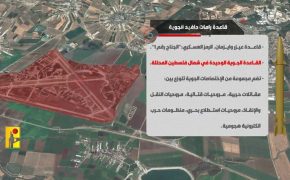
Comment